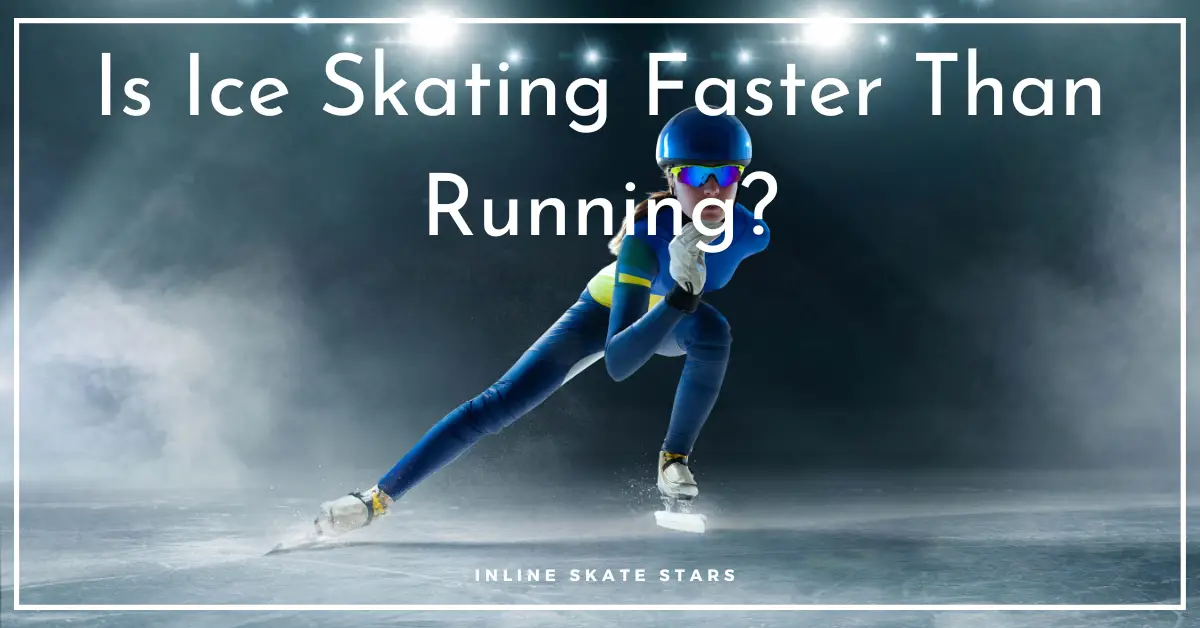Is ice skating faster than running? As the weather starts to warm up, many people turn to ice skating as an enjoyable way to stay active.
But is ice skating faster than running? The answer is yes, but it depends on the person.
I cover in detail why ice skating is faster than running in this comprehensive guide, and you don’t want to miss out. So, read on!
Is Ice Skating Faster Than Running?
Is ice skating faster than running? Ice skating is much faster than running since it produces very low levels of air resistance, making it easier for skaters to reach top speeds.
It’s also faster since it uses special ice skates that enhance movement, more muscles for locomotion, and doesn’t deplete blood sugar fast.
Ice skaters can also pull off techniques like the double push to go fast on ice. On the contrary, runners don’t have this advantage.
Overall, ice skaters can achieve a higher speed of 103 kmh (64mph) than the 44.72 kmh (27.78 mph) seen in running.
How fast can you ice skate on Ice?
The speed limit for skating on natural ice is about 20 mph, and skaters can generally go faster than that when they have the skills and equipment.
Professional skating competitions usually use a higher speed limit of around 48 mph.
People just starting may be able to go slightly slower, around 18 or 19 mph. But even at this speed, it’s possible to cover a lot of ground in short amounts of time!
According to an NBC BAY Area report, Short-track speed skaters commonly achieve speeds above 30 mph, whereas long-track speed skaters may achieve speeds over 35 mph.
More experienced ice skaters like Kjeld Nuis have managed to pull off a high speed of 103 kmh, equivalent to 64mph.
He broke his record on a straight 3 km natural ice rink on the Savalen Lake in Tynset.
How fast can you Run?
A regular person can run at a maximum speed of about 23.35 mph for men and 21.32 mph for women.
That’s the speed at which the body produces enough energy to keep running, even if you lift your feet off the ground most of the time.
On the contrary, more professional athletes like Usain Bolt have recorded high speeds of up to 27.78 mph (44.72 kmh).
Below I explain some of the reasons ice skating is faster than running!
1. Ice Skates Enhance Movement
Ice skaters move more smoothly and with less impact because they use ice skates specifically designed for this purpose.
There are four types of ice skates; speed skates, figure skates, hockey skates, and recreational skates.
Ice speed skaters use speed skating boots to reach higher speeds than typical runners.
Speed skates have longer and extended blades. They’re also lightweight, sturdy, and flexible, allowing smooth foot movement.
Skaters can stay upright on an icy, slick surface thanks to speed skate boots blades.
These skates’ blades make grooves in the track for the skate to move smoothly.
2. Ice Skating Uses More Muscles for Locomotion
Ice skaters use more muscles when skating than a regular person running because ice skating utilizes different muscle groups and patterns of movement.
Instead of simply using their feet to push off the ground, ice skaters use their entire leg, core, and upper body while skating.
This movement requires much more muscle power, endurance, and balance than running.
3. Ice Skating Uses Aerodynamics
According to NASA, aerodynamics is how air moves around things. Ice skates use aerodynamics to create speed.
When skating on the ice, your skate blade and body push against the air and create a forward motion.
This is in contrast to running, where the body resists the wind.
4. Ice Skating Uses Double Push
The double push is a skating motion that skaters use to speed up on the ice.
When you skate, you move your skates in opposite directions simultaneously as you push off the ground with your feet.
This motion helps to propel you forward quicker and more efficiently on the ice.
5. Ice skating Doesn’t Deplete Blood Sugar Fast
Ice skating requires energy but doesn’t deplete blood sugar as fast as running.
Ice skating requires a lot of upper body and leg muscle power, which usually won’t take as much glucose out of your bloodstream as running will.
This is also because ice skating uses ice skates and isn’t as mechanical as running.
Short Track vs. Long Track Speed Skating
Below is the comparison between short track and long track speed skating!
Short Track Speed Skating
Athletes in short track speed skating compete against each other rather than the clock.
This exemplifies the demands of racing in terms of strategy, bravery, and skill.
In Canada and the United States, short track (or indoor) speed skating began in 1905-1906, with mass-start competitions on an oval track.
Skaters race on an indoor rink with a lap length of 111 meters (364 feet) in groups of four to eight competitors.
The next round is entered by the top two finishers from each heat.
Long Track Speed Skating
The Olympic sport of long-track speed skating is the event in which athletes are timed as they cross a specified distance on the long track.
Long track speed skating uses standardized and non-standardized oval rink tracks.
Standardized tracks are often 400m long, with a curve radius of 25 to 26m, while non-standardized tracks can be 200 or 250m.
Also, the tracks only have two lanes, each about 3-4m wide. So, only two participants can compete in a single race.
Is Ice Skating Faster Than Running? FAQs
1. Is speed skating harder than running?
While speed skating and running are highly cardiovascular exercises, speed skaters require more endurance and strength since the ice surface is unforgiving.
Speed skaters must maintain high intensity for long periods to succeed.
On the other hand, runners don’t necessarily need as much endurance since they can take shorter breaks between intervals or when they reach their destination.
Additionally, runners have more leeway about how fast they can go without injury.
For these reasons, running may be a better option if you’re looking for an easy aerobic workout that doesn’t involve too much pain or stress on your joints.
2. Is ice skating as good as running?
While ice skating may not be as good as running when it comes to burning calories, it is a great way to get your heart rate up and increase fitness overall.
Both activities are aerobic and can help improve cardiorespiratory health by increasing the amount of oxygen you consume.
They are both excellent forms of stress relief that can reduce anxiety levels and promote better sleep habits.
Ice skaters also have more dance-like movements than runners, contributing to their cardio benefits.
Ice skating is an inclusive sport that is great for all ages and abilities – perfect for staying fit during the winter!
3. What is the difference between figure skating and speed skating?
Figure skating is a more graceful and theatrical form of speed skating that often features elaborate costumes and choreography.
Figure skaters are generally smaller in stature than speed skaters, and they use their bodies much more creatively to execute jumps, spins, and turns.
Speed skating demands excellent physical fitness because it involves faster speeds over longer distances.
Speed skaters need strong quads (the front thigh muscles), calves, glutes (buttocks), shoulders, back, core strength, upper-body endurance, and mental toughness.
This sport is dangerous if not mastered correctly because much momentum is involved at high speeds.
Ultimately, figure skating may be preferred by those who want to take their performances to the next level while keeping things clean and creative.
Is Ice Skating Faster Than Running? | Wrapping Up
It is fair to say that ice skating is faster than running, but the degree to which this speed difference exists can vary significantly depending on the type of skating being performed.
Both activities are aerobic and can help improve cardiorespiratory health by increasing the amount of oxygen you consume.




